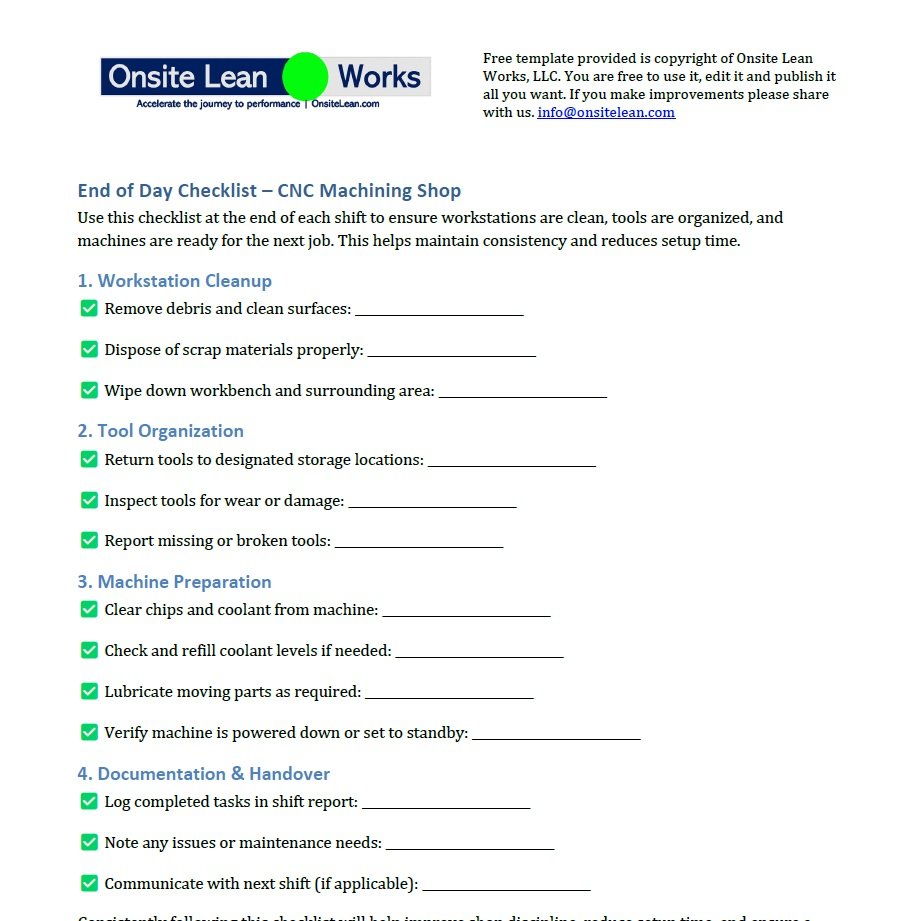Op Plays 0125: Start everyday running right with this End of the day checklist
How many times have you walked thru the beginning of the morning shift, only to see machines not running and the operator cleaning up or searching for a tool ?
Or how many times have your heard the the morning shift crew blame night shift crew for not cleaning up?
In any manufacturing operation, efficiency isn’t just about how well machines run—it’s also about how well they are maintained and prepared for the next job. A disorganized or unclean workstation can slow production, create safety hazards, and even damage expensive equipment. That’s why having a structured End-of-Day Checklist is crucial to keeping everything in top shape, shift after shift.
Advantages to complete these tasks at the end of shift:
Could be done while a product is running in the machine
Easy to return each handtools, machine tools and other items are their designated home
Items requiring attention like maintenance or replacement can be addressed or atleast not a surprise the next day
Everyday starts with a clean sheet, similar the “broken window” concept, it will be easy to spot when something is out-of-place
Make this an easy habit to train:
Customize the checklist for each machine with specific tips for the machine (eg. “only use XXX coolant”)
Add a large picture of the machine area with numbered labels marking all the things to be done
Format it, Print it, laminate it , hook a dry erase marker and Place at eye-level at the workbench. The operator is encouraged to check the boxes at the end each shift.
Designate a table or desk area, where people can drop off
Leadership tips to encourage discipline:
No point having a checklist if nobody does it!
Ultimately, it falls on the team’s supervisor or leader to encourage the discipline. Getting a team to take on a new habit requires repetition, 1:1 engagement and a little peer pressure. Here are a few conversational tips to help you encourage the team to stick to it:
Repetition: During the last hour of the shift, ask with just 1 team member about the checklist , and ask about just 1 item on the checklist. Do this this everyday but with a different team member.
While at a machine, ask the operator if there is something they would like to add / edit /remove. If reasonable, mark it up infront of them and make the change. Now its theirs! They own it.
When avoidable s**t happens, tie back LOST time at beginning of shift to following the checklist yesterday
Let’s walk through the key steps your team should follow sometime during the last 30mins of the days
End-of-Day Checklist for a CNC Machining Shop
Download the free checklist template here:
https://acrobat.adobe.com/id/urn:aaid:sc:va6c2:e7e461ce-06ec-44cf-9475-0625c50bb3d0
1. Workstation Cleanup: A Fresh Start for Every Shift
Imagine walking into a shop where the workbench is cluttered with metal shavings, coolant spills, and tools scattered everywhere. Not only does this slow you down, but it also increases the risk of mistakes. Before wrapping up the day, every machinist should:
✅ Remove debris and clean surfaces - Wipe down work areas and remove any leftover materials from the day's jobs.
✅ Dispose of scrap properly – Separate reusable materials from waste and follow shop disposal protocols.
✅ Wipe down benches and surrounding areas – A clean workspace isn’t just about appearance; it ensures that dust and grime don’t contaminate precision parts.
2. Tool Organization: Keeping Everything in Its Place
A misplaced tool can cost valuable minutes—or worse, halt production entirely. Keeping tools organized ensures machinists can hit the ground running at the start of their shifts.
✅ Return tools to designated storage – Every tool should have a home, and it should always be returned there after use.
✅ Inspect tools for wear and damage – A dull end mill or a cracked gauge can lead to inaccurate machining and wasted materials.
✅ Report missing or broken tools – If something is damaged or lost, it needs to be addressed before the next shift begins.
3. Machine Preparation: Setting Up for Success
CNC machines are the heart of the shop, and ensuring they’re well-maintained reduces downtime and improves efficiency.
✅ Clear chips and coolant buildup – Built-up debris can affect machine performance and even lead to damage.
✅ Check and refill coolant levels – Low coolant levels can cause overheating and impact cutting precision.
✅ Lubricate moving parts as needed – Regular lubrication extends the life of machine components.
✅ Power down or set machines to standby – Ensure machines are properly shut down or set to standby mode for safety and efficiency.
4. Documentation & Shift Handover: Closing the Loop
Good communication between shifts prevents issues from being overlooked and keeps production moving smoothly.
✅ Log completed tasks – Keep records of what’s been done and any adjustments made to setups or machine settings.
✅ Note any issues or maintenance needs – If a machine is acting up or a part needs replacing, document it.
✅ Communicate with the next shift – If another team is coming in, brief them on any outstanding tasks or concerns.
Why This Checklist Matters
By consistently following this end-of-day routine, CNC shops can reduce setup time, improve efficiency, and extend the life of tools and machines. It ensures that every shift starts fresh with a clean, organized, and well-maintained workspace—keeping production on schedule and maintaining high-quality standards.
Make this checklist a daily habit, and your shop will run like a well-oiled machine—literally!


